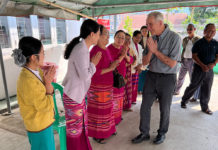Know the facts
Editors: One lesson to be drawn from recent events at Palm Drive
is that words have power and imprudent words have imprudent power.
Rash statements, unsubstantiated charges, and headlines and
editorials that focus attention on one small aspect of a complex,
multi-layered story with a long history influence the minds of
readers who cannot possibly know all of the facts.
It bears repeating that Palm Drive has made a remarkable
recovery over the last 2 1/2 years and is now operating in the
black for the first time in a decade, with expanded and improved
services in many areas. This rise from the ashes is not due to any
one person alone, but the collective effort of hundreds of people
whose desire has always been for a better future for our community.
Taxpayers, donors, volunteers, staff, physicians, the Palm Drive
Foundation, the County of Sonoma, Exchange Bank, Kaiser Hospital,
local businesses, our Joint Powers Authority partners (Healdsburg,
Sonoma Valley and Fort Bragg hospitals) and countless others have
rallied together to create this miracle.
There are many heroes in this story. It has been our personal
honor to collaborate with our community during this challenging
time, and we look forward to working together in the future.
– Dan Smith, Palm Drive District Board President; Joan
Marler, Sebastopol
Save the Gualala
Editor: What if the third largest winery in the world, based in
Spain, chose the recovering Gualala River watershed for a large
forest-to-vineyard conversion project that further impacted the
river’s flow, water purity, and its endangered fish? The bad news
is that this is exactly what has happened. The good news is that,
with your help, this multinational company can be prevented from
profiting at the expense of our river. The company is Codorniu; the
plan is called the “Fairfax/Artesa” conversion, and it is located
on Annapolis Road above the Wheatfield Fork of the Gualala
River.
The proposal calls for 171 acres of redwood forest to be cut
down, roots ripped out, water diversion culverts buried to fill a 9
acre rubber lined reservoir, and miles of wildlife fencing
constructed around 200 acres of vineyard. Just some of the negative
affects include fragmentation of habitat, contributions to global
warming, and degradation of the already impaired river. More
information and the project’s Draft Environmental Impact Report
(DEIR) can be found at www.gualalariver.org, the website
of Friends of the Gualala River (FOGR). This local volunteer
organization is devoted to protecting the river from
environmentally destructive projects such as this. FOGR was
instrumental in defeating the “water bag” project from a few years
ago that proposed to ship Gualala River water to San Diego in
ocean-going rubber bladders.
– Chris Poehlmann, Annapolis
47.6
F
Healdsburg
April 22, 2025








